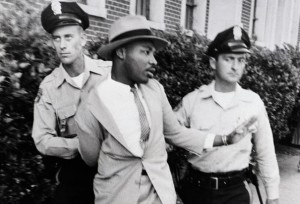 Yesterday’s national observance of Martin Luther King, Jr.’s holiday—arriving in the wake of the violent death of Michael Brown in Ferguson, MO and a series of similar incidents—elicited a stream of posts and hashtags criticizing sanitized depictions of MLK’s legacy. This annual commemoration induces moral discomfort as it seems to invite facile interpretations of MLK’s person, legacy, theology, and politics. As a Chicana Catholic, I am often disturbed by the appropriation of my own cultural and political heroes—César Chávez, for example—and central religious exemplars—La Virgen de Guadalupe, for example—on their respective holidays. I furrow my brow as I scroll through social media newsfeeds where apparently well-meaning people from beyond this community wrench these figures from their particular narrative and symbolic contexts without fully engaging their particular meanings. For example, Guadalupe’s feast day features calls for justice under her banner from a diverse array of religious and political causes, but these articulations usually overlook essential ingredients of this narrative: her appearance to Juan Diego and her particularly Mexican manifestation. Roberto Goizueta, using Guadalupe as his example, critically describes this process of appropriation:
Yesterday’s national observance of Martin Luther King, Jr.’s holiday—arriving in the wake of the violent death of Michael Brown in Ferguson, MO and a series of similar incidents—elicited a stream of posts and hashtags criticizing sanitized depictions of MLK’s legacy. This annual commemoration induces moral discomfort as it seems to invite facile interpretations of MLK’s person, legacy, theology, and politics. As a Chicana Catholic, I am often disturbed by the appropriation of my own cultural and political heroes—César Chávez, for example—and central religious exemplars—La Virgen de Guadalupe, for example—on their respective holidays. I furrow my brow as I scroll through social media newsfeeds where apparently well-meaning people from beyond this community wrench these figures from their particular narrative and symbolic contexts without fully engaging their particular meanings. For example, Guadalupe’s feast day features calls for justice under her banner from a diverse array of religious and political causes, but these articulations usually overlook essential ingredients of this narrative: her appearance to Juan Diego and her particularly Mexican manifestation. Roberto Goizueta, using Guadalupe as his example, critically describes this process of appropriation:
“Once concrete symbols become mere symbols divorced from any specific, intrinsic content, their meaning is liberated from the constraints imposed by their specific, sociohistorical concreteness. So, for example, if the symbol of Our Lady of Guadalupe is understood apart from its visible concreteness in the form of a dark-skinned Lady who appeared on Tepeyac to a Nahua man, Juan Diego, she will be universalized, seen as simply one among many Marian symbols, and thereby stripped of her identification with a particular people. Such an identification in no way precludes universal meaning, but that meaning is accessible only in and through one’s own solidarity and identification with her people. If we want to discover the meaning of Guadalupe for us, we must enter into solidarity with her people.” (Christ Our Companion, 69)
This solidaristic posture means privileging Mexican, Mexican-American, and Chicano/a interpretations of her image before–or instead of–marshaling the image for our own ends. This means listening first and speaking later. This means listening, letting the community speak for itself, and then listening some more. In the academy, we struggle to encounter voices outside of our disciplined conversation that can give nuanced accounts of the meaning of this image in its own context. We give up on the pursuit of these interactions at our own peril. Indeed, extricating these images, or simply claiming them as one’s own without cultivating genuine solidarity with the community from which they emerge, leads to what Vince Miller has aptly described as “virtual solidarity.”
This same dynamic can be observed in the celebration of the MLK holiday. As one who seeks genuine solidarity with the Black community—albeit always imperfectly—I am disturbed by flat appropriations of MLKs life, work, and theology. This dynamic is illustrated by the public portrayal of King’s image. The national monument erected in his honor, for example, features an image of a strong, confident, and courageous man cast in stone and encircled by quotations fished from the shallow waters of his deeper theological and political program. Other images represent him as a successful democrat, rousing the crowd gathered on the National Mall with his iconic, “I Have a Dream” speech. These depictions are not bankrupt in themselves; he was, by all authoritative accounts, a man of tremendous fortitude and charisma. Yet, this “icon treatment” obscures important aspects of both his personal and political identity. The heroic image on display at his monument, for example, cannot fully capture his vulnerability, cockiness, fear, or infidelity; these characteristics reveal significant dimensions of this particular human life. The heroic image glosses over acts of tenderness, mercy, and disdain that fall outside of the hyper-masculine MLK icon. One response to this sanitization has been for posters and bloggers to display images of King that fall outside of the visual canon. In an effort to link the #BlackLivesMatter protests of today with the mid-twentieth century Civil Rights legacy, some posters have displayed images of MLK being arrested for acts of non-violent resistance. These images disrupt sanitized narratives that attempt to sunder yesterday’s struggle from today’s conflicts.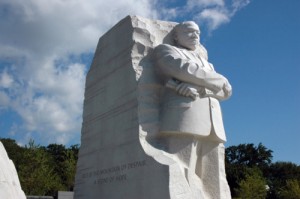
Even as I critique misappropriations of MLK’s image and legacy—as well as narratives, images, and practices arising from other marginalized communities—it is necessary to think about the ethics of appropriation in a society where we seek to establish and sustain a common public life. How, in a robustly plural context, do we engage symbols, narratives, and movements that arise from beyond our own particular religious, ethnic, racial, and political communities? What are appropriate cultural and religious models of respect that resist co-optation and promote shared democratic power and leadership? What ethical principles ought to undergird the hermeneutical task in public life? In the meantime, there is a need for intellectual and cultural humility in encounters with religious and cultural images, narratives, symbols, and—above all—persons across difference in our pursuit of a common public life.

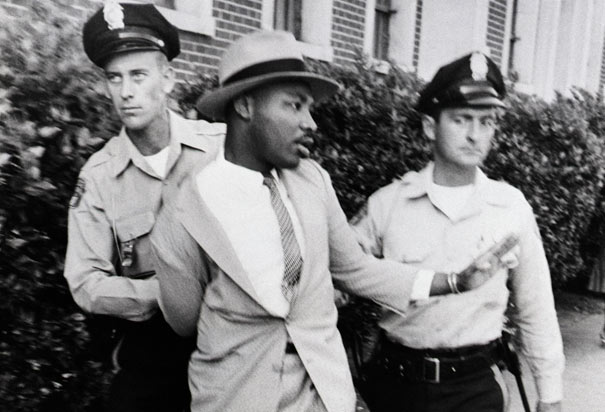

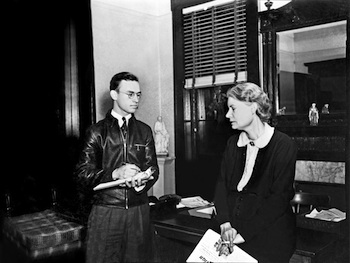
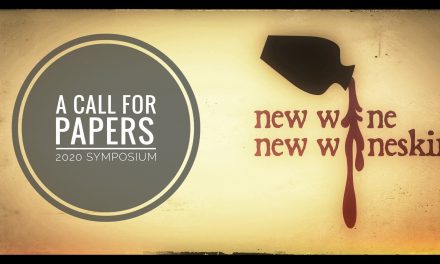
Trackbacks/Pingbacks